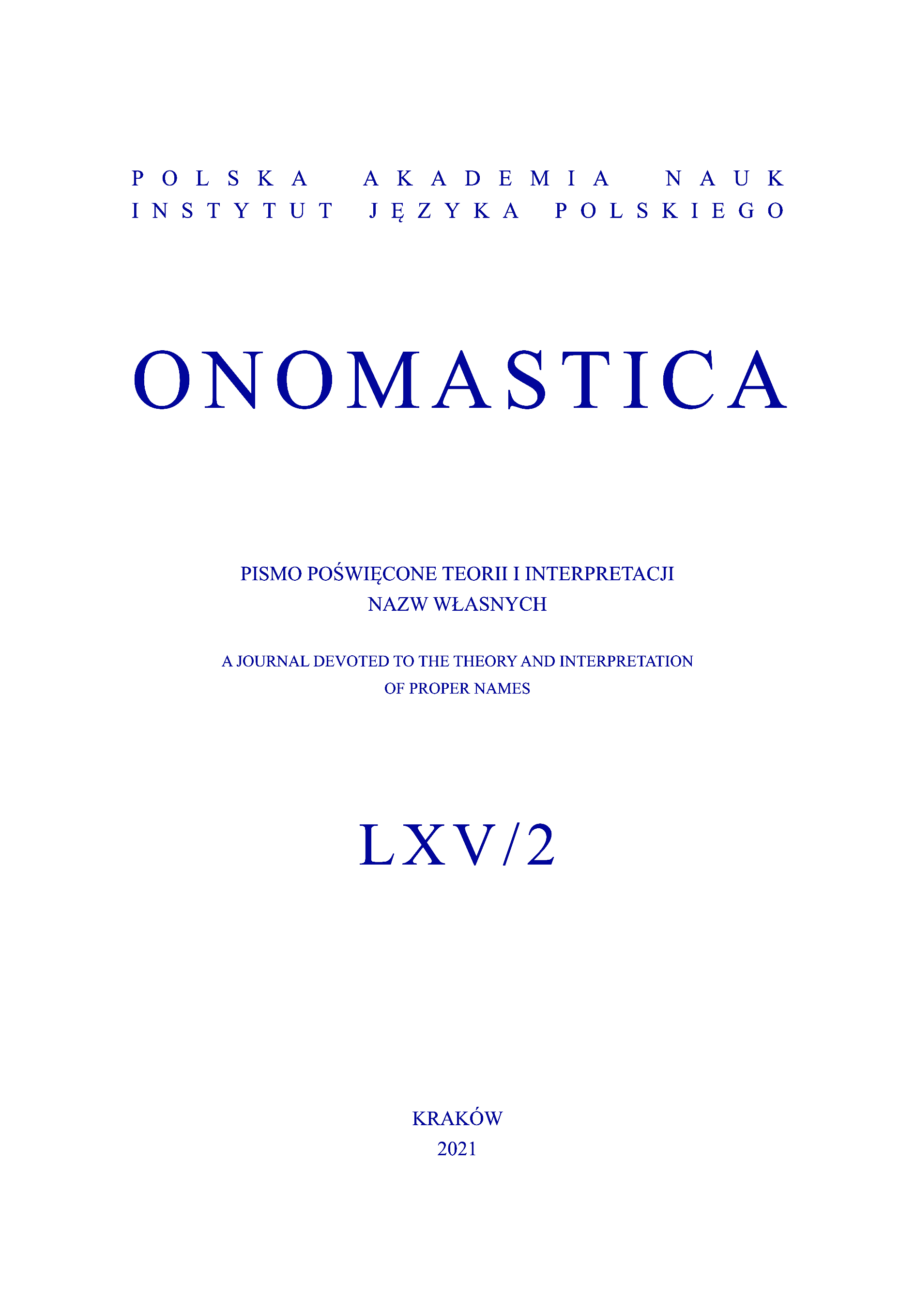Abstract
The subject of the article is the unique nature of Polish and Ukrainian names of sweets, the motives for their creation and the sociopolitical and cultural circumstances in which they were formed. A comparative analysis showed that both Polish and Ukrainian names shape the image of these products in a similar way. They inform the potential customer about the interior of the product (i.e. the product content, its taste, as well as the type of sweets) and about its outer side, i.e. its texture, shape and function. Other elements of the characteristics go beyond the physically experienced object. They relate to its market characteristics and create the image of its recipients, inherently embedded in the product name, not only specifying their character (sports fans, students, children, adults, or the elderly), but also suggesting the season and time of day when particular products can be enjoyed. The names also specify the place and the occasion for possible tasting, emphasizing the important values of the food product: its local / regional character and its originality. Ukrainian names express regionalism in two ways: by reference to old brand names from the USSR times and by their translation into Ukrainian, and — to a much lesser extent, compared to Polish names — by endonyms. In the Ukrainian marketing space, in contrast with the Polish one, foreign names are also very popular. In Ukrainian brand names, names from color terms are more numerous, similarly to the titles of literary works and the names of their heroes.
References
Gałkowski, A. (2008). Chrematonimy w funkcji kulturowo-użytkowej. Onomastyczne studium porównawcze na materiale polskim, włoskim i francuskim [Chrematonymy in the Cultural and Utility Function. Onomastic comparative study on Polish, Italian, and French material]. Łódź: Wydawnictwo UŁ.
Idzikowska, M. (2000). Imiona osobowe w roli chrematonimów (na przykładzie nazw artykułów handlowych) [Personal names as chrematonyms (on the example of the names of commercial items)]. W: M. Czachorowska i Ł.M. Szewczyk (red.), Onomastyka polska a nowe kierunki językoznawcze [Polish Onomastics and New Linguistic Trends] (s. 211–221). Bydgoszcz: Wydawnictwo Uczelniane WSP.
Jaros, V. (2011). Techniki nominacyjne w zakresie współczesnego nazewnictwa wyrobów piekarniczych i cukierniczych [Nomination techniques in the field of modern naming of bakery and confectionery products]. W: M. Biolik i J. Duma (red.), Chrematonimia jako fenomen współczesności [Chrematonymy as a Phenomenon of Modern Times] (s. 215–233). Olsztyn: Wydawnictwo UWM.
Kalenȗk, S. i Voronȗk, K. (2018). Specifika leksiko-semantičnih grup čokonimiv ukraїns’koї movi [Specificity of lexical and semantic groups of choconyms in Ukrainian language]. Naukovi zapiski Nacional’nogo universitetu, “Ostroz’ka akademiâ”. Seriâ Filologiâ, 1(69), 169–171.
Kosmeda, T. (2019). Interpretacìâ ìdeologemi „Ukraїns’ka mova” v sučasnomu rosìjs’komu movoznavstvì: „Mova, âk i priroda, ne maê zloї volì…” [Interpretation of the ideologeme “Ukrainian language” in modern Russian linguistics: “Language as well as nature has no evil intentions…”. Lìngvìstični Studії, 38, 78–83.
Laforet, S. i Saunders, J. (1994). Managing brand portfolios: How the leaders do it. Journal of Advertising Research, 34(5), 64–76.
Lech-Kirstein, D. (2011). Kreacje nazewnicze w nazwach drinków [Name creations in drink names]. W: M. Biolik i J. Duma (red.), Chrematonimia jako fenomen współczesności [Chrematonymy as a Phenomenon of Modern Times] (s. 283–292). Olsztyn: Wydawnictwo UWM.
Lučik, V.V. (2003). Hrematonimiâ (ergonimiâ) [Chrematonymy (ergonymy)]. W: E. Rzetelska Feleszko, A. Cieślikowa i J. Duma (red.), Słowiańska onomastyka [Slavic Onomastics] (t. II, s. 390–394). Warszawa–Kraków: Towarzystwo Naukowe Warszawskie.
Magda-Czekaj, M. (2011). Czy nazw herbat to chrematonimy? [Are the names of the teas chrematonymy]. W: M. Biolik i J. Duma (red.), Chrematonimia jako fenomen współczesności [Chrematonymy as a Phenomenon of Modern Times] (s. 311–318). Olsztyn: Wydawnictwo UWM.
Olszański, T.A. (2012). Problem językowy na Ukrainie. Próba nowego spojrzenia [The Language Issue in Ukraine. An attempt at a new perspective]. Warszawa: Ośrodek Studiów Wschodnich im. M. Karpia.
Pawlak, C. (2017). Konflikt na wschodzie Ukrainy i aneksja Krymu — standardowym przykładem działań hybrydowych [Conflict in the East Ukraine and the annexation of Crimea — a standard example of hybrid activities]. Rocznik Bezpieczeństwa Międzynarodowego, 11(1), 268–287.
Rutkiewicz-Hanczewska, M. (2003). Nazwy wiedeńskich aptek — schemat nazewniczy czy specyfika miejsca? [Names of Viennese pharmacies — naming model of specificity of the place]. Onomastica Slavogermanica, 24, 173–181.
Rutkiewicz-Hanczewska, M. (2007). Farmakonimy jako narzędzie brandingu [Drug names as a branding tool]. Język Polski, 87(3), 199–211.
Rutkiewicz-Hanczewska, M. (2013). Genologia onimiczna. Nazwa własna w płaszczyźnie motywacyjno-komunikatywnej [Onymic Genology. Proper name on motivational and communicational level]. Poznań: Wydawnictwo Poznańskie.
Rutkiewicz-Hanczewska, M. (2019). Nazwy w nazwach, czyli o współczesnych nazwach handlowych i granicach ich tworzenia [Names in names, or modern trade names and boundaries of their creation]. W: A. Chomová, J. Krško i I. Valentová (red.), Konvergencie a divergencie v propriálnej sfére [Convergence and Divergence in the Proprial Sphere] (s. 401–410). Banská Bystrica: Vydavatel’stwo Slovenskej Akadémie Vied VEDA.
Rutkowski, M. (2003). Nazwy na sprzedaż. O nazewnictwie na usługach marketing [Names for sale. On onomastics for marketing]. Onomastica, 48, 239–254.
Serczyk, W.A. (2009). Historia Ukrainy [History of Ukraine]. Wrocław: Zakład Narodowy im. Ossolińskich.
Stępniewski, T. (2016). Konflikt zbrojny Rosji z Ukrainą i negocjacje pokojowe w Mińsku [Russo- ‑Ukrainian Armed Confl ict and Minsk Peace Talks]. Studia Europejskie, 3, 43–59.
Tomecka-Mirek, A. (2010). Leon i Elektryczna Pomarańcza, czyli o uwodzeniu nazwą. Tendencje w tworzeniu nazw soków, nektarów i napojów [Leon and An Electric Orange — about trifling with the name. The tendencies in creating names of juices, nectars, and drinks]. W: R. Łobodzińska (red.), Nazwy własne i społeczeństwo [Proper Names and Society] (t. II, s. 357–370). Łask: Oficyna Wydawnicza „Leksem”.
Toussaint-Samat, M. (2002). Historia naturalna i moralna jedzenia [Natural and Moral History of Foods]. Warszawa: Wydawnictwo W.A.B.
Wochelski, M. (2020). Historyczne i polityczne aspekty ukraińskiej drogi ku niepodległości [Historical and political aspects of Ukrainian way to independence]. Refleksje, 22, 71–86.
Yermolenko, S. i Zymovets’, H. (2018). Some issues in research of eponymous business name motivation (with reference to Ukrainian onomasticon). Lìngvìstični Studії, 36, 110–116.
Želâzkova, V.V. (2019). Ukraїns’komovnì čokonìmi u vimìrì semìotiki [Ukrainian choconyms in the dimension of semiotics]. Molodij včenij, 4.3(68.3), 100–103.


